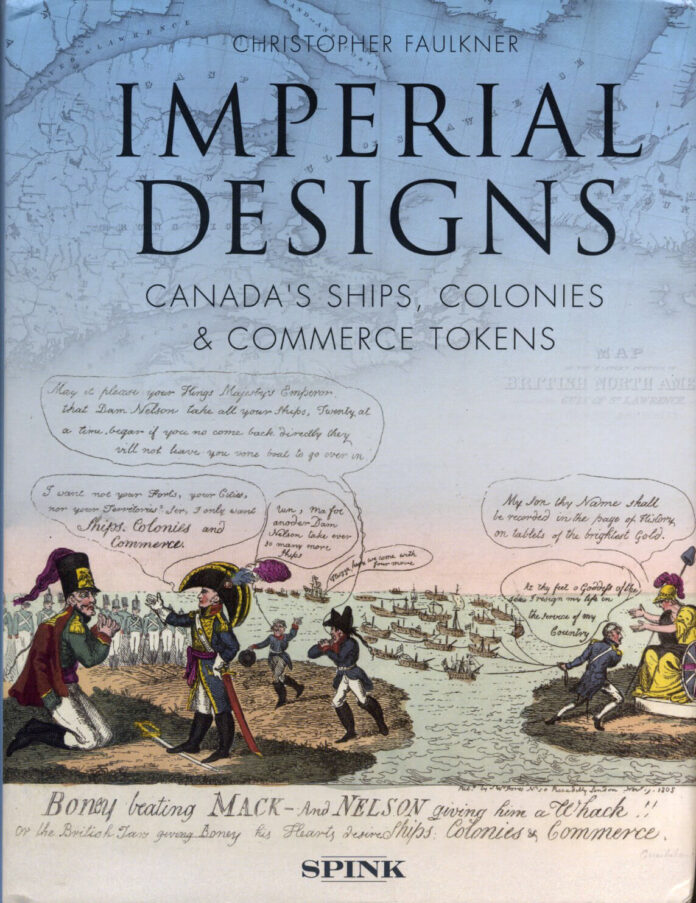
The Dominion of Canada was founded on 1 July 1867. This placed the northern areas of the United States, which had previously been a Hudson Bay Company hotbed and a paradise for trappers, in a more official position than ever before. From then on, the government of the Canadian territories, of course under the sovereignty of Great Britain, took on the responsibility of providing their citizens with sufficient circulation money. And thus, all the private attempts to remedy Canada’s lack of money became obsolete.
After all, of course there had been coins and tokens in Canada before! How else could one have maintained a somewhat regulated trading process? One of the most important currencies – besides the omnipresent beaver fur – was a certain type of token, which depicted a ship on the obverse and the inscription Ships, Colonies & Commerce on the reverse. Christopher Faulkner dedicates a comprehensive monograph with more than 400 pages to this single type of token, of which new emissions have been issued over a period of more than 30 years.
The Historical Context
Of course, every reader will be confronted with the question: Is it even worth it? Can one write that much about these tokens?
We do not know how often the author has been asked this question. Yet it must have been often enough for Christopher Faulkner to feel compelled to answer this question in a small, dramatically orchestrated scene at the beginning of his book. And so he realizes that he wants nothing less than to illustrate the historical economic background on the basis of which these tokens had to emerge in this particular way.
The author thereby raises four fundamental questions:
- What are the historical contexts – for there is more than one – in which the Ships, Colonies & Commerce tokens, with their familiar device and legend, made their appearance?
- When, where and by whom were the different groups of Ships, Colonies & Commerce tokens struck?
- When, where and by whom were the different groups of Ships, Colonies & Commerce tokens imported and put into circulation?
- What is the numismatic history concerning the identification and description of the numerous varieties in this series?
And this is exactly how the author approaches his subject. First, he outlines the historical background on which the tokens were created. He tells of the timber trade and shipbuilding on Prince Edward Island. He explains the legend on the basis of the economic ideology of the time, mercantilism.
The second chapter deals with all those who made these tokens. Where were the mints located? How certain can we be about the correlation between them and the products of certain periods of time?
And who – we read in the third chapter – brought them into the country? Of course, this was not a single location. It is a highly complex process that Faulkner tries to reconstruct for the individual territories.
A Catalogue for Hardcore Collectors
And then comes the main part: The part that will drive tears of enthusiasm to the faces of hardcore collectors, the part in which every variety, however small, is described and checked for meaningful significance. As I said, only suitable for hardcore collectors. The outsider won’t see any difference on the extremely dark pictures anyway, in spite of excerpts pointing out what one should see. The printer should have provided better hard-proofs so that the color setting could have been changed and brightened a little. Good thing that the author describes the varieties in such detail that you can identify them from the description. The catalogue comprises nearly 300 of the publication’s more than 400 pages. And I honestly admit that, without previous knowledge, I do not really want to determine a variety within the catalogue.
With two biographies of the most important collectors and researchers of Ships, Colonies & Commerce tokens, we have almost reached the end of the book. Christopher Faulkner introduces W. A. D. Lees and L. A. Langstroth before he discusses mint errors in an appendix. An index opens up the comprehensive book.
A Book for Specialist Collectors and for Those Interested in Economic History
Christopher Faulkner has published an impressive book. Each line of the book reflects the author’s enthusiasm for his subject. To appreciate the work invested in this exhaustive monograph by the author, one would have to be an avid collector of Ships, Colonies & Commerce tokens as well.
Nonetheless, the work also has plenty to offer to readers interested in economic history. It provides insight into the economy of a newly developed country without a central authority that insists on using a certain kind of money. Featuring detailed background information, the Canada of fur hunters and small settlements, where people lived together, traded and sold services, all without a truly functioning monetary system, comes to life for us.
This part of the book is important for those who want to understand how an economy works with and without money, how autarky and occasional trade complement each other. However, these readers will only find the few pages of the introduction enjoyable and leave the other pages to specialist collectors.
You can order the comprehensive and richly illustrated work directly at Spink.
The preparatory draft for this book was published in 2016. The work, which is currently available at a discounted price, bears the beautiful title “Coins are like Songs”.




